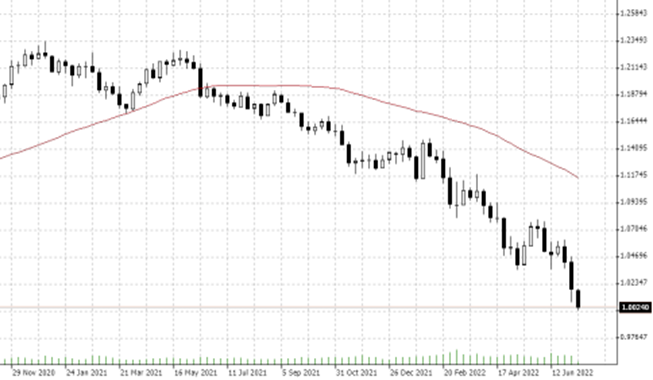

12.07.2022 – It’s done: the euro has just slipped to parity with the dollar. For the first time in two decades. We, too, pay homage to the event. And shed light on pros and cons for a further slide.
Bad news for all those who want to go on vacation to the USA: One euro buys only about one dollar. This means that the pan-European lira, sorry: the transcontinental soft currency, sorry: the European common currency is once again as weak as it has been since October 2002, shortly after the introduction of the euro. A rapid descent, as you can see in the weekly chart.

Source: Bernstein Bank GmbH
So where do we go from here? Brad Bechtel, Foreign-Exchange Strategist at Jefferies LLC can now envision a counter-movement: “it feels like EUR/USD is oversold on many technical measures and parity was such a target for so many people in the market that it wouldn’t surprise if we see a lot of profit taking down here and a short term bounce.” Indeed, the euro has already dipped well below the 50 moving average, crying out for a rebound.
Energy crisis and risk of recession
However, there are also hefty drags. The majority of analysts blame the gas crisis in particular for the development. Fears of a recession in Europe persist among investors, so one analyst sees further opportunities for the bears: “The worst case (total stop of gas flows) brings recession and probably another 10% fall by the euro from here,” judged Chief Forex Strategist Kit Juckes of Société Générale.
If energy prices continue to rise, it will also support the dollar for another reason – the U.S. produces oil and gas, which fills the treasury; this tends not to be the case in eurozone countries. We’ll see what happens next: yesterday, Monday, the Nord Stream 1 gas pipeline was shut down, with an initial ten days for maintenance. Whether Russia will supply gas again after that remains to be seen.
USA quicker to turn around interest rates
And then, of course, there is the Federal Reserve’s faster pace in turning around interest rates. The U.S. key interest rate is at 1.5 to 1.75 percent, and the Fed has hinted at further steps. The key rate in Euroland is zero, and analysts expect at least a 0.25 percent increase at the next Governing Council meeting.
Moreover, there is a related factor that tends to be swept under the rug in this country: The fact that the European Central Bank continues to blithely buy bonds from crisis states. And in return it prints cheap money, in other words, creates digital money out of thin air. This is the only way Portugal, Italy, Greece and Spain can survive. And that’s precisely why the ECB can’t raise interest rates as quickly and as sharply as the Fed – otherwise the national budgets of the crisis countries will blow up in their faces because the debts can no longer be serviced. And how wonderful: Croatia is soon to join the euro zone. The next prop is guaranteed!
The conclusion to be drawn from all this: risk-averse, long-term investors are looking for their salvation in U.S. government bonds – the yield there is better. And by buying the bonds, the dollar rises. As always in a crisis, the greenback is king. We are curious to see how the EURUSD develops further – and wish you successful trades and investments!
Important Notes on This Publication:
The content of this publication is for general information purposes only. In this context, it is neither an individual investment recommendation or advice nor an offer to purchase or sell securities or other financial products. The content in question and all the information contained therein do not in any way replace individual investor- or investment-oriented advice. No reliable forecast or indication for the future is possible with respect to any presentation or information on the present or past performance of the relevant underlying assets. All information and data presented in this publication are based on reliable sources. However, Bernstein Bank does not guarantee that the information and data contained in this publication is up-to-date, correct and complete. Securities traded on the financial markets are subject to price fluctuations. A contract for difference (CFD) is also a financial instrument with leverage effect. Against this backdrop, CFD trading involves a high risk up to the point of total loss and may not be suitable for all investors. Therefore, make sure that you have fully understood all the correlating risks. If necessary, ask for independent advice. CFDs are complex instruments and are associated with the high risk of losing money quickly because of the leverage effect. 68% of retail investor accounts lose money trading CFD with this provider. You should consider whether you understand how CFD work and whether you can afford to take the high risk of losing your money.7
